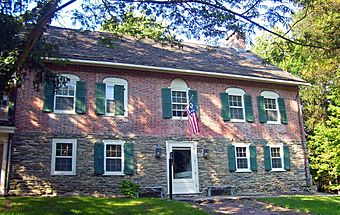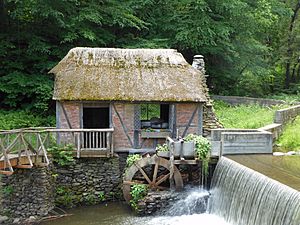Gomez Mill House facts for kids
Quick facts for kids |
|
|
Gomez Mill House
|
|

The Mill House in 2007. The original stone from 1714 can still be seen on the first floor.
|
|
| Location | Town of Newburgh, NY |
|---|---|
| Nearest city | Newburgh |
| Built | 1714 |
| Architect | Jacob and Daniel Gomez (first floor) Wolfert Acker (second floor and attic) |
| NRHP reference No. | 73001245 |
| Added to NRHP | 1973 |
The Gomez Mill House is a historic home in the Town of Newburgh, New York. At over 300 years old, it is the oldest known home built by a Jewish family in North America that is still standing. It is also the oldest house in Orange County to be listed on the National Register of Historic Places, a list of important historic sites in the United States.
Contents
History of the Gomez Mill House
The story of the Gomez Mill House involves many different owners who each added to its long and interesting history.
The Gomez Family Builds a Home
The house was first built by Luis Moses Gomez, a Sephardic Jewish merchant. His family had to flee Spain many years earlier to escape the Spanish Inquisition, a time when people were treated badly for their religious beliefs. Gomez came to New York in the late 1690s to find a new life.
In 1705, he bought a special document from Queen Anne. This paper gave him the right to own property and run a business in the British colonies without having to promise loyalty to the Church of England. This allowed him to become a successful businessman and a leader in New York's Jewish community.
In 1714, Gomez bought 1,000 acres (400 ha) of land in what was then the British colony of New York. He and his sons later bought another 3,000 acres (1,200 ha). On this land, they built a single-story house made of large, rough stones called fieldstone. The walls were three feet thick, making it very strong. This original stone building is now the first floor of the Gomez Mill House. For over 30 years, his son Daniel ran a successful family business from the house, selling lumber and limestone.
Changes During the Revolutionary War
In 1772, just before the American Revolutionary War, a Dutch colonist named Wolfert Acker bought the property. He added a second floor and an attic to the house using bricks made from local clay. This gave the main part of the house the shape it has today.
During the war, Acker was a member of the local militia. He was also in charge of the local Committee of Safety, a group that helped organize the American side of the war effort.
New Owners and Additions
In 1835, a wealthy landowner named Edward Armstrong purchased the Mill House. After he died, his son William Henry Armstrong moved in. During the 50 years his family lived there, they added a kitchen wing and garden walls.
The house had several other owners over the next century. One of the most famous was Dard Hunter, a papermaker who was part of the Arts and Crafts movement. This movement focused on making beautiful things by hand. In 1912, Hunter bought the house and built a small paper mill on the property. For the next few years, he made special handmade paper and printed books there.
The House Becomes a Museum
In 1947, after World War II, Mildred and Jeffrey Starin bought the house. Mildred was an antique dealer and was the first owner to realize how important the house was to American history. Thanks to her efforts, the Gomez Mill House was added to the National Register of Historic Places in 1973.
In 1984, a group called the Gomez Foundation for Mill House bought the property. This foundation was started by descendants of Luis Moses Gomez and other people who wanted to protect the house. Today, the foundation runs the Gomez Mill House as a museum, so visitors can learn about its incredible 300-year history.


